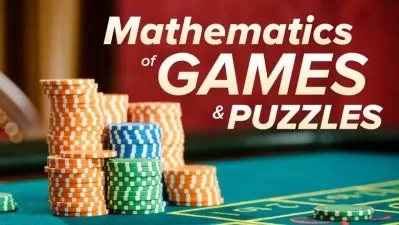CIE International A-Level Maths: Mechanics
Woody Lewenstein
10:44:11
Description
Master the content from Paper 4 (Mechanics) of Cambridge International A-Level Maths
What You'll Learn?
- Velocity and Acceleration
- Forces and Newton's Laws of Motion
- Friction
- Equilibrium
- Energy and Power
Who is this for?
What You Need to Know?
More details
DescriptionCIE International A-Level Maths is a course for anyone studying the Cambridge International A-Level Maths:
This course covers all the content in Paper 4 (Mechanics) of the Cambridge International A-Level Maths Course. It is also a great introduction to mechanics for anyone interested in getting started.
The main sections of the course are:
- Velocity and Acceleration- we look at using graphs and SUVAT equations to solve a range of kinematics problems.
- Forces and Motion - we learn how to use Newton's laws of motion to analyse the forces acting on objects to determine their motion.
- Variable Acceleration - we learn how to use calculus to solve problems where an object's motion can be expressed as a function of time.
- Forces and Friction - we learn how to use a model for friction and apply it to understand how it affects the motion of objects.
- Equilibrium - we learn how to understand systems in equilibrium, looking at limiting equilibrium and and other more advanced concepts.
- Work, Energy and Power - we learn what these concepts are and how to use them to solve problems relating to kinetic and potential energy.
- Momentum - we learn what momentum is and how to use it to solve problems relating to colliding particles.
Please note: This course is intended for people studying the Cambridge International A-Level Maths Syllabus, and not the UK syllabus (covered by Edexcel, OCR, AQA and MEI exam boards). If you are looking for these, check out my other courses on these!
What you get in this course:
Videos: Watch as I explain each topic, introducing all the key ideas, and then go through a range of different examples, covering all the important ideas in each. In these videos I also point out the most common misconceptions and errors so that you can avoid them.
Quizzes: Each sub-section is followed by a short quiz for you to test your understanding of the content just covered. Most of the questions in the quizzes are taken from real A-Level past papers. Feel free to ask for help if you get stuck on these!
Worksheets: At the end of each chapter I have made a collection of different questions taken from real A-Level past papers for you to put it all together and try for yourself. At the bottom of each worksheet is a full mark-scheme so you can see how you have done.
This course comes with:
· A printable Udemy certificate of completion.
· Support in the Q&A section - ask me if you get stuck!
I really hope you enjoy this course!
Woody
Who this course is for:
- People studying the Cambridge International A-Level Mathematics AS or A-Level
- People who want to study an intermediate course in mechanics
CIE International A-Level Maths is a course for anyone studying the Cambridge International A-Level Maths:
This course covers all the content in Paper 4 (Mechanics) of the Cambridge International A-Level Maths Course. It is also a great introduction to mechanics for anyone interested in getting started.
The main sections of the course are:
- Velocity and Acceleration- we look at using graphs and SUVAT equations to solve a range of kinematics problems.
- Forces and Motion - we learn how to use Newton's laws of motion to analyse the forces acting on objects to determine their motion.
- Variable Acceleration - we learn how to use calculus to solve problems where an object's motion can be expressed as a function of time.
- Forces and Friction - we learn how to use a model for friction and apply it to understand how it affects the motion of objects.
- Equilibrium - we learn how to understand systems in equilibrium, looking at limiting equilibrium and and other more advanced concepts.
- Work, Energy and Power - we learn what these concepts are and how to use them to solve problems relating to kinetic and potential energy.
- Momentum - we learn what momentum is and how to use it to solve problems relating to colliding particles.
Please note: This course is intended for people studying the Cambridge International A-Level Maths Syllabus, and not the UK syllabus (covered by Edexcel, OCR, AQA and MEI exam boards). If you are looking for these, check out my other courses on these!
What you get in this course:
Videos: Watch as I explain each topic, introducing all the key ideas, and then go through a range of different examples, covering all the important ideas in each. In these videos I also point out the most common misconceptions and errors so that you can avoid them.
Quizzes: Each sub-section is followed by a short quiz for you to test your understanding of the content just covered. Most of the questions in the quizzes are taken from real A-Level past papers. Feel free to ask for help if you get stuck on these!
Worksheets: At the end of each chapter I have made a collection of different questions taken from real A-Level past papers for you to put it all together and try for yourself. At the bottom of each worksheet is a full mark-scheme so you can see how you have done.
This course comes with:
· A printable Udemy certificate of completion.
· Support in the Q&A section - ask me if you get stuck!
I really hope you enjoy this course!
Woody
Who this course is for:
- People studying the Cambridge International A-Level Mathematics AS or A-Level
- People who want to study an intermediate course in mechanics
User Reviews
Rating
Woody Lewenstein
Instructor's Courses
Udemy
View courses Udemy- language english
- Training sessions 76
- duration 10:44:11
- Release Date 2023/09/10










